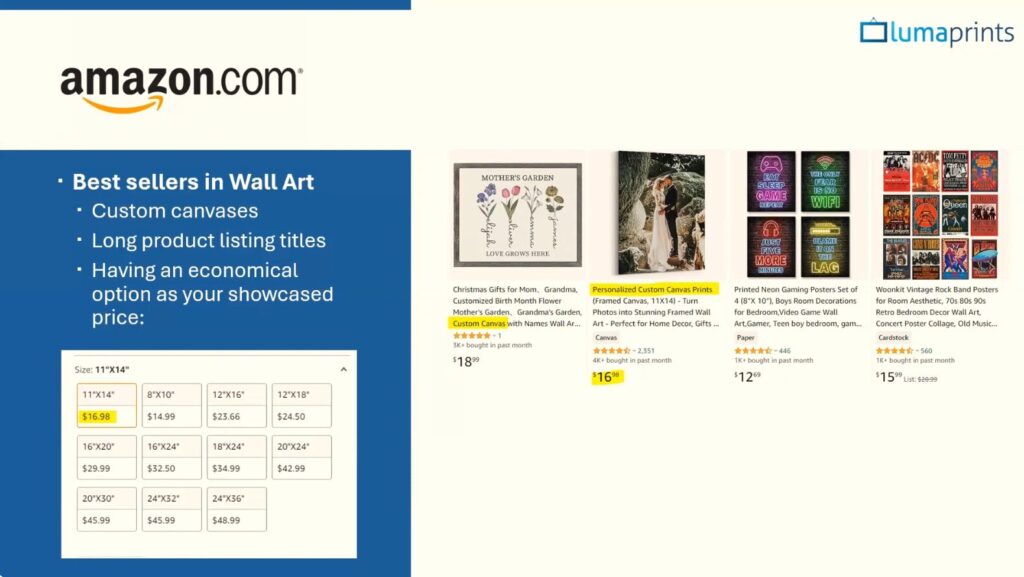For this webinar, we delved into the intricacies of Marketplace selling and examine emerging trends as we head into 2024. We’ll also take a closer look at four prominent marketplaces to understand their dynamics and what has worked well for sellers in recent years.
In simple terms, a Marketplace is where you sell your products under a specific brand, while e-commerce entails running your standalone store. There are significant differences between the two, including product stipulations, brand visibility, advertising strategies, and SEO tactics.
If you like reading more than watching, we’ve got you. Read on for all the instructions. You can also jump to any topic you want from the list below.
Etsy: Crafting Success in a Niche Market
Wayfair: Redefining Home Shopping Experiences
Walmart: Bridging the Gap Between Retail and Online
Understanding Marketplaces
Before diving into the specifics, let’s briefly discuss the essence of Marketplaces:
- Amazon: The giant of e-commerce, known for its vast customer base and exponential growth over the years. Despite its dominance, there’s still ample opportunity for sellers to thrive.
- Etsy: A niche platform with a strong emphasis on individual sellers and unique, handcrafted products. It’s a community-driven marketplace that values craftsmanship and authenticity.
- Wayfair: Specializing in home furnishings and décor, Wayfair offers a curated selection of products with a focus on quality and style.
- Walmart: A retail behemoth that has successfully transitioned into the online marketplace space. With a stringent approval process, Walmart ensures high standards for its sellers.
Amazon: A Seller’s Paradise
Let’s start with Amazon, where the numbers speak volumes. With over $3 billion in sales in 2022 alone, Amazon continues to dominate the e-commerce landscape. Third-party sellers, in particular, have witnessed significant growth, underscoring the platform’s appeal to independent vendors.

- Third-Party Sellers: Despite Amazon’s own fulfillment services, third-party sellers thrive on the platform, catering to diverse consumer needs.

- Selling Plans: Amazon offers flexible selling plans, making it accessible for sellers of all scales. Whether you’re testing the waters or scaling up, there’s a plan for you.
- Bestselling Categories: Customizable items, especially canvases, reign supreme on Amazon. Long, descriptive product titles and strategic pricing play a crucial role in driving sales.

Etsy: Crafting Success in a Niche Market
Etsy stands out as a haven for artisans and creators, fostering a sense of community and authenticity. With a focus on handmade and vintage items, it appeals to a discerning audience seeking unique products.

- Community-Centric: Etsy’s strong community ethos resonates with buyers looking for personalized, artisanal goods.
- Listing Costs: With a cost-per-listing model, Etsy provides an affordable entry point for sellers. It encourages experimentation and product testing.
- Trending Genres: Bohemian and farmhouse aesthetics thrive on Etsy, reflecting the platform’s penchant for organic, nature-inspired designs.
Wayfair: Redefining Home Shopping Experiences
As a destination for home furnishings and décor, Wayfair offers a curated selection of products catering to diverse tastes and preferences. Its approval-based model ensures quality and consistency across offerings.

- Approval Process: Wayfair’s vetting process maintains high standards, fostering trust and credibility among buyers.
- Uniform Pricing: By standardizing prices, Wayfair creates a level playing field for sellers, promoting fair competition and transparency.
- Targeted Marketing: Pay-per-click advertising allows sellers to engage with customers effectively, optimizing marketing efforts for maximum impact.
Walmart: Bridging the Gap Between Retail and Online
Walmart’s foray into the online marketplace space has been met with significant success, thanks to its vast customer base and strategic partnerships. With a focus on quality assurance and customer satisfaction, it offers a seamless shopping experience for buyers.

- Vetting Process: Walmart maintains stringent criteria for sellers, ensuring a curated selection of products that meet its standards.
- Commission-Based Model: Sellers pay a commission fee for each purchase made, aligning incentives and driving mutual success.
- Explosive Growth: Walmart’s online sales witnessed a substantial surge in recent years, reflecting shifting consumer preferences and increasing digital adoption.
Conclusion
As we navigate the ever-evolving landscape of marketplace selling, it’s crucial to stay attuned to emerging trends and consumer preferences. Whether you’re a seasoned seller or just starting out, understanding the nuances of each platform is key to success.
By leveraging the unique features and opportunities offered by platforms like Amazon, Etsy, Wayfair, and Walmart, sellers can tap into a vast pool of customers and expand their reach exponentially.
As we look ahead to 2024 and beyond, let’s embrace innovation, adaptability, and a customer-centric approach to thrive in the dynamic world of marketplace selling.
Watch this webinar through this link: https://youtu.be/RvFAcfqk78o?si=qMfjT2QZgx2weZkL
All previous and upcoming webinar videos are available on our YouTube channel: https://www.youtube.com/@lumaprints

![[WEBINAR] POD Dropshipping Marketplace Trends For 2024](https://www.lumaprints.com/wp-content/uploads/2024/02/unnamed-7.jpg)



